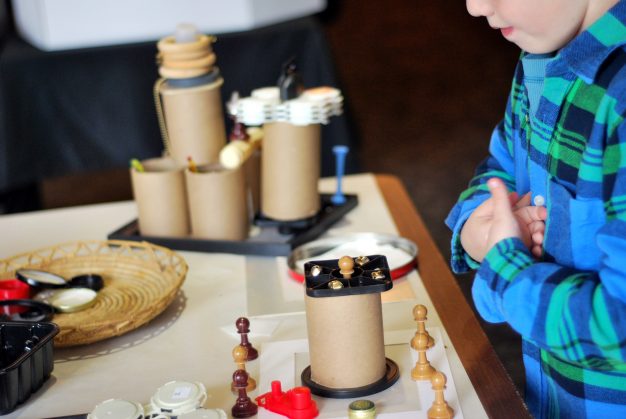
Loose parts play is highly engaging for children
“In any environment, both the degree of inventiveness and creativity, and the possibility of discovery, are directly proportional to the number and kind of variables in it.” Simon Nicholson, 1972, p. 5.
When community activities attempt to be ‘child and family friendly’, we often see the same offerings: hula-hoops, sidewalk chalk, face painting and other such tried and tested ‘kids’ stuff’. Children enjoy all of these things, of course, but are we missing an opportunity to truly engage communities in creative thinking? With so many activities vying for attention in children’s daily lives, how can we help them to get the most out of playtime?
LOOSE PARTS
‘Loose Parts’ is the term, coined by architect Simon Nicholson, for open-ended materials that can be manipulated in different ways: moved, combined, taken apart or reassembled. Cardboard, bottle caps, rocks, wire, and spools are just a few examples: the possibilities are endless. By offering children loose parts to manipulate, they have an opportunity to create, work, and play on their own terms, exploring what is most interesting to them. Loose parts can be big or small, but what matters most is that they draw users in, to interact and play.
Nicholson’s theory of loose parts is based on design and architecture, playing around with objects and ideas without a specific goal in mind. Nicholson stressed that design and creativity are not concepts reserved for the artistic elite. On the contrary, there is no artistic elite: all people, especially children, crave and need creative experiences. By expanding our idea of how a community might play and learn together, we have an opportunity for everyone to experience building, making, doing, and thinking – while being highly engaged in the process.
Our understandings of loose parts and their application has grown and evolved as the theory has become more widely known, especially among early childhood educators. Topal and Gandini (1999) suggest that ‘one way to rediscover our own creative impulses is to see possibilities in materials’ (p. xii). Often inspired by the Reggio Emilia approach, teachers have found that using loose parts and presenting them in a way that draws children to interact is highly engaging and is a completely creative experience.
Taking loose parts out of the classroom and bringing them into the community can create a novel offering, helping to engage children and families. Loose parts are also cheap, and often free or recycled meaning there are few barriers to adopting and implementing this deeply engaging concept.
IMPLICATIONS FOR COMMUNITY ENGAGEMENT
If we shift our thinking about the ‘what’ of children’s spaces in the community, we have an opportunity not only to engage participants in community spaces, but also to provide open-ended opportunities for exploration in an increasingly structured educational landscape. Creating opportunities for children and families using materials that allow participants to make the majority of the choices allows project coordinators to observe play and understand what the community is interested in. This, too, can be inspired and informed by high-quality early childhood practices, where the teacher’s role stretches far beyond teaching content to children.
Loose parts can be part of a truer reflection of a community and its culture, because the materials we can access and use changes from place to place. From planned festivals to pop-up play events and educational spaces, loose parts can provide a window into a community at play. Embedding the theory is making a commitment to children, giving them the time, space, and materials to explore the world through play.
References:
Author: Allie Pasquier (http://www.play-lab.org)
Nicholson, S. (1972). The Theory of Loose Parts. Studies in Design Education Craft & Technology 4 (2), pp.5-14. http://jil.lboro.ac.uk/ojs/index.php/SDEC/article/view/1204/1171
Topal, C. and Gandini, L. (1999). Beautiful Stuff! Learning with found materials. Worcester, MA: Davis Publications.




